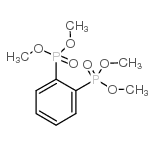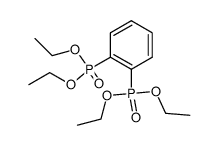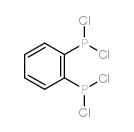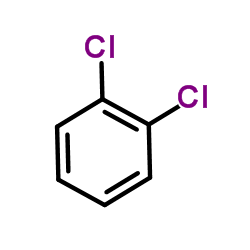1,2-bis(phosphino)benzene
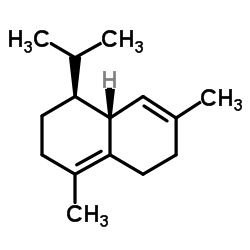
1,2-bis(phosphino)benzene structure
|
Common Name | 1,2-bis(phosphino)benzene | ||
|---|---|---|---|---|
| CAS Number | 80510-04-9 | Molecular Weight | 204.351 | |
| Density | 0.9±0.1 g/cm3 | Boiling Point | 279.7±15.0 °C at 760 mmHg | |
| Molecular Formula | C15H24 | Melting Point | N/A | |
| MSDS | N/A | Flash Point | 110.5±15.2 °C | |
| Name | (2-phosphanylphenyl)phosphane |
|---|---|
| Synonym | More Synonyms |
| Density | 0.9±0.1 g/cm3 |
|---|---|
| Boiling Point | 279.7±15.0 °C at 760 mmHg |
| Molecular Formula | C15H24 |
| Molecular Weight | 204.351 |
| Flash Point | 110.5±15.2 °C |
| Exact Mass | 204.187805 |
| PSA | 27.18000 |
| LogP | 6.54 |
| Appearance of Characters | liquid | colorless |
| Vapour Pressure | 0.0±0.3 mmHg at 25°C |
| Index of Refraction | 1.499 |
|
Section 1: Product Identification Chemical Name:1,2-Bis(phosphino)benzene, 98+% CAS Registry Number:80510-04-9 Formula:C6H4(PH2)2 EINECS Number:none Chemical Family:organophosphine ligand Synonym:none
Section 2: Composition and Information on Ingredients IngredientCAS NumberPercentACGIH (TWA)OSHA (PEL) Title Compound80510-04-9100%no datano data Section 3: Hazards Identification Harmful by inhalation, in contact with skin and if swallowed. May ignite spontaneously on contact with air. Emergency Overview: Contact with skin may result in severe chemical burns. Primary Routes of Exposure:Skin and inhalation Eye Contact:May cause mild to severe irritation of the eyes. Skin Contact:Harmful in contact with skin. May cause mild irritation of the skin, or thermal burns if ignited. Inhalation:Harmful by inhalation. Inhalation may lead to dizziness and headaches. Harmful if swallowed. Ingestion is an unlikely mode of entry as the material is pyrophoric and has a noxious Ingestion: odor. Acute Health Affects:Harmful by inhalation, in contact with skin and if swallowed. Chronic Health Affects:No information available on long term exposure to this material. NTP:No IARC:No OSHA:No SECTION 4: First Aid Measures Immediately flush the eyes with copious amounts of water for at least 15 minutes. A victim will need Eye Exposure: assistance in keeping their eye lids open. Get immediate medical attention. Wash the affected area immediately with water. Remove contaminated clothing if necessary. Seek medical Skin Exposure: assistance if irritation persists. Remove victim to fresh air immediately. Keep the victim lying down and warm. Give oxygen as soon as Inhalation: possible. If shock occurs, respond with appropriate first aid. Transport the victim to a hospital. Seek medical attention immediately. Keep the victim calm. Give water to dilute the toxin (only if conscious). Ingestion: Induce vomiting only if directed by medical personnel. SECTION 5: Fire Fighting Measures Flash Point:no data Autoignition Temperature:Pyrophoric Explosion Limits:Pyrophoric Extinguishing Medium:carbon dioxide, dry powder or foam The pyrophoric liquid may reignite. Fire fighters should be equipped with an approved positive pressure Special Fire Fighting Procedures: self-contained breathing apparatus and full protective clothing. Hazardous Combustion andIf involved in a fire this material may emit toxic organic fumes and vapors of phosphorus pentoxide. Decomposion Products: Unusual Fire or Explosion Hazards: Spontaneously flammable in air, especially in contact with organic matter such as paper or cloth. SECTION 6: Accidental Release Measures 'The material may ignite spontaneously in air. Avoid static discharge. Burning material may release toxic fumes. In case of poor ventilation, leave the area unless fitted with a self-contained breathing apparatus. Spill and Leak Procedures: Small spills can be mixed with ground limestone, sodium bicarbonate, or other suitable absorbents, swept up, and held in a closed metal can. SECTION 7: Handling and Storage Store in a tightly sealed container under an inert atmosphere of nitrogen or argon. Keep away from heat. Handling and Storage:Material should be transferred under an inert atmosphere of nitrogen or argon in a efficient fume hood. Fire may occur in emptied container and transfer lines. SECTION 8: Exposure Controls and Personal Protection Always wear approved safety glasses. When handling this substance wear a face shield as added protection. Eye Protection: Skin Protection:Wear protective clothing and gloves. Consult with glove manufacturer to determine the proper type of glove. Ventilation:Material has a pungent odor. Always handle material in an efficient fume hood. If ventilation is not available a respirator should be worn. The use of respirators requires a Respirator Respirator: Protection Program to be in compliance 29 CFR 1910.134. Ventilation:Material has a pungent odor. Always handle material in an efficient fume hood. Additional Protection:Wear a full face shield, flame resistant lab apron and suitable gloves. SECTION 9: Physical and Chemical Properties Color and Form:colorless liq. Molecular Weight:142.08 Melting Point:no data Boiling Point:53-55°C /0.25mm Vapor Pressure:no data Specific Gravity:no data Odor:pungent and noxious odor Solubility in Water:insoluble SECTION 10: Stability and Reactivity Stability:air-sensitive, pyrophoric liquid Hazardous Polymerization:no hazardous polymerization Contact with air. Material may spontaneously ignite, especially in the presence of organic matter such as Conditions to Avoid: paper or cloth. Incompatibility:oxidizing agents, halogens, air (pyrophoric), halocarbons, sulfur. Decomposition Products:carbon dioxide, carbon monoxide, organic vapors, and phosphorus pentoxide. SECTION 11: Toxicological Information RTECS Data:No information available in the RTECS files. Carcinogenic Effects:No information available. Mutagenic Effects:No information available. Tetratogenic Effects:No information available. SECTION 12: Ecological Information Ecological Information:No information available. SECTION 13: Disposal Considerations Disposal:Dispose of this material according to local, state and federal regulations. SECTION 14: Transportation Shipping Name (CFR):Pyrophoric liquids, organic, N.O.S. Hazard Class (CFR):4.2 Additional Hazard Class (CFR):NA Packaging Group (CFR):I UN ID Number (CFR):UN# 2845 Shipping Name (IATA):Forbidden Hazard Class (IATA):NA Additional Hazard Class (IATA):NA Packaging Group (IATA):NA UN ID Number (IATA):NA SECTION 15: Regulatory Information TSCA:not listed on the TSCA inventory SARA (Title 313):not regulated by SARA 313 Second Ingredient:none SECTION 16 - ADDITIONAL INFORMATION N/A |
| Hazard Codes | F: Flammable; |
|---|---|
| Risk Phrases | R17 |
| Safety Phrases | 7/8-26-36/37/39-43-27-16 |
| RIDADR | UN 2924 |
| HS Code | 2931900090 |
|
~79% 
1,2-bis(phosphi... CAS#:80510-04-9 |
| Literature: Hitchcock, Peter B.; Lappert, Michael F.; Leung, Wing-Por; Yin, Ping Journal of the Chemical Society, Dalton Transactions: Inorganic Chemistry (1972-1999), 1995 , p. 3925 - 3932 |
|
~50% 
1,2-bis(phosphi... CAS#:80510-04-9 |
| Literature: Kyba, Even P.; Rines, Steven P.; Owens, Philip W.; Chou, Shang-Shing P. Tetrahedron Letters, 1981 , vol. 22, # 20 p. 1875 - 1878 |
|
~69% 
1,2-bis(phosphi... CAS#:80510-04-9 |
| Literature: Woerz, H.-J.; Quien, E.; Latscha, H. P. Zeitschrift fuer Naturforschung, Teil B: Anorganische Chemie, Organische Chemie, 1984 , vol. 39, # 12 p. 1706 - 1710 |
|
~% 
1,2-bis(phosphi... CAS#:80510-04-9 |
| Literature: Cytec Technology Corp. Patent: US6563005 B1, 2003 ; |
|
~% 
1,2-bis(phosphi... CAS#:80510-04-9 |
| Literature: Issleib, K.; Leissring, E.; Meyer, H. Tetrahedron Letters, 1981 , vol. 22, # 45 p. 4475 - 4478 |
|
~% 
1,2-bis(phosphi... CAS#:80510-04-9 |
| Literature: Hitchcock, Peter B.; Lappert, Michael F.; Leung, Wing-Por; Yin, Ping Journal of the Chemical Society, Dalton Transactions: Inorganic Chemistry (1972-1999), 1995 , p. 3925 - 3932 |
| HS Code | 2931900090 |
|---|---|
| Summary | 2931900090. other organo-inorganic compounds. VAT:17.0%. Tax rebate rate:13.0%. Supervision conditions:AB(certificate of inspection for goods inward,certificate of inspection for goods outward). MFN tariff:6.5%. General tariff:30.0% |
| (1S,8aR)-1-Isopropyl-4,7-dimethyl-1,2,3,5,6,8a-hexahydronaphthalene |
| (1S,8aR)-4,7-Dimethyl-1-(propan-2-yl)-1,2,3,5,6,8a-hexahydronaphthalene |
| UNII-7848KI47OS |
| Naphthalene, 1,2,3,5,6,8a-hexahydro-4,7-dimethyl-1-(1-methylethyl)-, (1S,8aR)- |
| (+)-δ-cadinene |
| (1S,8aR)-4,7-dimethyl-1-propan-2-yl-1,2,3,5,6,8a-hexahydronaphthalene |
| MFCD00142463 |
| Naphthalene, 1,2,3,5,6,8a-hexahydro-4,7-dimethyl-1-(1-methylethyl)-, (1S-cis)- |
| 1,2-diphosphinobenzene |
| 1,2-Phenylenediphosphane |
| (+)-d-Cadinene |
| d-Cadinene |
| (+)-delta-cadinene |
